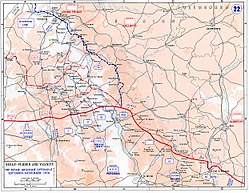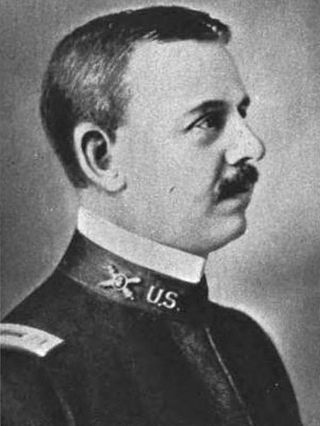
This is the order of battle for the American Expeditionary Force at the beginning and end of the Meuse-Argonne Offensive, September 26 to November 11, 1918.

This is the order of battle for the American Expeditionary Force at the beginning and end of the Meuse-Argonne Offensive, September 26 to November 11, 1918.
General John J. Pershing, Commanding

Major General Hunter Liggett, Commanding
III Corps Major General Robert Lee Bullard, Commanding
V Corps Major General George H. Cameron, Commanding
In Reserve
General John J. Pershing, Army Group Commander
Lieutenant General Hunter Liggett, Commanding
I Corps Major General Joseph T. Dickman, Commanding

III Corps Major General John L. Hines, Commanding
V Corps Major General Charles P. Summerall, Commanding
Lieutenant General Robert L. Bullard, Commanding
IV Corps Major General Charles H. Muir, Commanding
VI Corps Major General Charles C. Ballou, Commanding
(Note: With the exception of one brigade from the 88th Division, VI Corps did not actively participate in the battle.)
French II Colonial Corps
French XVII Corps
At one point or another during the 47-day battle, all or part of 23 American divisions were engaged in the fighting:

The Meuse–Argonne offensive was a major part of the final Allied offensive of World War I that stretched along the entire Western Front. It was fought from September 26, 1918, until the Armistice of November 11, 1918, a total of 47 days. The Meuse–Argonne offensive was the largest in United States military history, involving 1.2 million French, Siamese, and American soldiers, sailors and marines. It is also the deadliest campaign in the history of the United States Army, resulting in over 350,000 casualties, including 28,000 German lives, 26,277 American lives and an unknown number of French lives. American losses were worsened by the inexperience of many of the troops, the tactics used during the early phases of the operation, and the widespread onset of the global influenza outbreak called the "Spanish flu."

The VII Army Corps of the United States Army was one of the two principal corps of the United States Army Europe during the Cold War. Activated in 1918 for World War I, it was reactivated for World War II and again during the Cold War. During both World War II and the Cold War it was subordinate to the Seventh Army, or USAREUR and was headquartered at Kelley Barracks in Stuttgart, West Germany, from 1951 until it was redeployed to the US after significant success in the Gulf War in 1991, then inactivated in 1992.

The VI Corps was activated as VI Army Corps in August 1918 at Neufchâteau, France, serving in the Lorraine Campaign. Constituted in the Organized Reserves in 1921, it was allotted to the Regular Army in 1933 and activated on 1 August 1940 at Fort Sheridan, Illinois. VI Corps took part in some of the most high-profile operations in World War II.

The Battle of Saint-Mihiel was a major World War I battle fought from 12–15 September 1918, involving the American Expeditionary Forces (AEF) and 110,000 French troops under the command of General John J. Pershing of the United States against German positions. The U.S. Army Air Service played a significant role in this action.

The 80th Training Command is a formation of the United States Army Reserve.
The Third Battle of Murfreesboro, also known as Wilkinson Pike or the Cedars, was fought December 5–7, 1864, in Rutherford County, Tennessee, as part of the Franklin-Nashville Campaign of the American Civil War.
The Malaya Command was a formation of the British Army formed in the 1920s for the coordination of the defences of British Malaya, which comprised the Straits Settlements, the Federated Malay States and the Unfederated Malay States. It consisted mainly of small garrison forces in Kuala Lumpur, Penang, Taiping, Seremban and Singapore.
The Order of battle for the American airborne landings in Normandy is a list of the units immediately available for combat on the Cotentin Peninsula between June 6, 1944, and June 15, 1944, during the American airborne landings in Normandy during World War II.
This list of United States Army divisions is divided into three eras: 1911–1917, 1917–1941, and 1941–present. These eras represent the major evolutions of army division structure. The 1911–1917 era lists divisions raised during the Army's first attempts at modernizing the division, prior to the authorization of permanent divisions, and the 1917–1941 era lists the first permanent divisions, prior to advent of specialized divisions. The 1941–present era lists all of the divisions organized, raised, or authorized since then.

The 7th (Meerut) Division was an infantry division of the Indian Army and before 1895, the Bengal Army, that saw active service during World War I.

This is the order of battle for Operation Cobra, a World War II American offensive against German forces in Normandy, France that lasted 25-31 July 1944.
On 25 March 1971, the Pakistani military, supported by paramilitary units, launched the military operation to pacify the insurgent-held areas of East Pakistan, which led to a prolonged conflict with the Bengali Mukti Bahini. Although conventional in nature during March–May 1971, it soon turned into a guerrilla insurgency from June of that year. Indian Army had not directly supported the Bengali resistance but had launched Operation Jackpot to support the insurgency from May 1971.
Lithuanian Athletics Championships is the national championship in athletics, organized by the Athletic Federation of Lithuania. The first competition was held in 1921. Women participated since the 1922 championship.

Adelbert Cronkhite was a career officer in the United States Army. He was notable for his command of the 80th Division during World War I. He also served as interim commander of IX Corps and commander of VI Corps after the war. In addition, his later command assignments included the Newport News Port of Debarkation, the Coast Artillery Training Center, and Third Corps Area.
Sixth Corps Area was a Corps area, effectively a military district, of the United States Army from 1921 to the 1940s. The headquarters was established at Fort Sheridan, Illinois, in August 1920, from portions of the former Central Department, but then moved to the U.S. Post Office Building at 1819 West Pershing Road in Chicago on 10 October 1921.

Brigadier General Michael Joseph Lenihan was a senior officer of the United States Army. He was involved in conflicts in the American Western Frontier, the Philippines, and World War I, where he commanded the 83rd Infantry Brigade, 42nd Division, during the Meuse–Argonne offensive while serving on the Western Front.

On 21 July 1944, United States Marine and Army forces invaded the island of Guam, the southernmost of the Mariana Islands chain in the Central Pacific, with the intent to take control of the island from the Imperial Japanese Army. Operation Forager II, as it was called by American planners, was a phase of the Pacific Theatre of World War II.
This article includes a list of references, related reading, or external links, but its sources remain unclear because it lacks inline citations .(August 2015) |